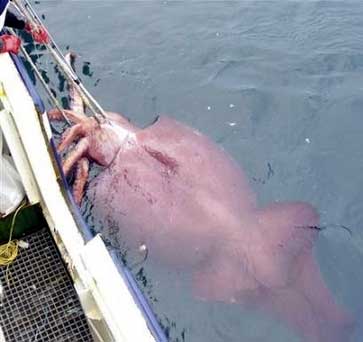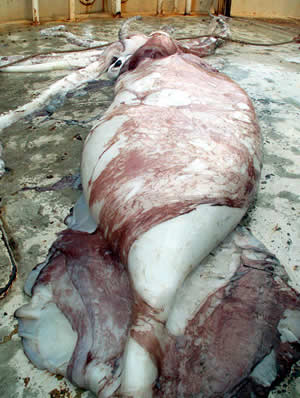The Kraken, it does exist...
-
Probably no legendary sea monster was as horrifying as the Kraken. According to stories this huge, many armed, creature could reach as high as the top of a sailing ship's main mast. A kraken would attack a ship by wrapping their arms around the hull and capsizing it. The crew would drown or be eaten by the monster. What's amazing about the kraken stories is that, of all the sea monster tales we have, now we have the best evidence that this creature was based on something real.







-
This post proves that big sotong exist.
-
Ya, like the one in Pirates of the carribean Dead Man's Chest.
-
if they are viewed as a luxurious delicacy like what sharks fins is like to certain groups of people... they probably wont have the chance to grow till that large :p
-
they cant be eaten like the regular small ones because they contain a very high concentration of ammonia.
-
They have a term for this species of animal. Forgot what was it.

-
Squid.
-
wasn't kraken supposed to be as big as an island?
-
so far they have not encountered the one that is big as the one in Pirates of the Caribbean. But they do exist in the very deep parts of the seas. Imagine those cruise ships encounter this thing.
-
Cool. But I guess the meat would be tough. No good no good.
-
Originally posted by Q.C.Pak:
They have a term for this species of animal. Forgot what was it.

Colossal squid.
-


CANBERRA (Reuters) - One of the largest giant squid ever found has washed up on a remote Australian beach, sparking a race against time by scientists to examine the rarely seen deep-ocean creature.
The squid, the mantle or main body of which measured two-meters (6.5 feet) long, was found by a walker late on Tuesday on Ocean Beach, near Strahan, on the western coast of island state Tasmania.
"It's a whopper," Tasmanian Museum senior curator Genefor Walker-Smith told local media on Wednesday. "The main mantle is about one meter across and its total length is about eight meters."
Scientists would take samples from the creature, identified by state parks officials as an Architeuthis, which can grow to more than 10 meters (33 feet) in length and weigh more than 275 kilograms (606 pounds). The Tasmanian animal was 250 kg, Pemberton said.
The tentacles had been badly damaged, so the overall length of the animal could not be determined, a Tasmania Parks and Wildlife spokeswoman said. Park rangers had moved the remains from the water.
Giant squid, once believed to be mythical despite occasional sightings by mariners, feed on fish and other squid. Last year, fishermen off the Falkland Islands caught a complete animal measuring 8.62 meters.
Scientists believe giant squid usually live at ocean depths of between 200-700 meters (660-2,300 ft), relying in part on volleyball-sized eyes, the largest in the animal kingdom.
Scientists said giant squid gathered along Australia's continental shelf in cold mid-winter waters to feed on Grenadier fish. The squid were in turn hunted by sperm whales migrating north from the Southern Ocean.
Japanese ocean researchers captured the first ever pictures of a live giant squid in September 2004 off Japan's Ogasawara Islands at a depth of 900 meters. -
Originally posted by Worldlybusinessman:
they cant be eaten like the regular small ones because they contain a very high concentration of ammonia.
no worries the chinese will find for a way
-
quite curious.. why large specimens got high ammonia?
is it in the squid ink?
-
Originally posted by chrystic:
quite curious.. why large specimens got high ammonia?
is it in the squid ink?
Btw they gather in some place near a beach in Tasmania.
-
Originally posted by chrystic:
if they are viewed as a luxurious delicacy like what sharks fins is like to certain groups of people... they probably wont have the chance to grow till that large :p
Clossal squid is a different species and there are different species within clossal squids.They are members of the class Cephalopoda, which includes octopus, nautilus, and extinct ammonite species.
-
A giant octopus was also discovered in 1890




The Lusca is a creature that the people of the Bahamas have seen for years. It matches the description of a giant octopus. Is that possible ? Pictured above are the remains of a unknown species of giant octopus ? While we know that giant squids do exist, it has never been confirmed that a giant octopus does, in fact, exist. The octopus would be more likely to attack ships and sailors than a squid would, so if there is a giant variety of the species, this could add credibility to stories of giant squid/octopus' attacking ships. The Kraken was a sea serpent that was seen by thousands of sailors. The Kraken description matches that of the giant squid. How many "Kraken" attacks were the work of an giant octopus ? An estimate on the size of the corpse in the picture if it was an octopus would make the octupus 150 to 200 feet tip to tip of the tenticles. The cell samples of the corpse were taken to the Smithsonian Institute in Washington DC and tested. The cells of the creature were not identical to, but very closely resembled the octopus more than any other type of sea creature.
-
While the kraken is believed to be an gigantic octopus , this is no less a gigantic squid . Their tentacles are generally shorter except for 2 main tentacles to grab food which are indeed very long . It is very unlikely that they will attack ship as its not as efficient as the octopus having tentacles that are all equally long . Not to mention a gigantc octopus having so much arm all equally long . And it is said that octopus distribute its brain among all its arms which means if an arm were to be broken , the new arm that is regrown will have to relearn its manipulation again .
-
Interesting!
-
Looks really scary leh!

Ammonia, hmm...it must be really smelly.
-
The truly giant ones ( as big as the blue whale) will not come to the surface. They will die because of the difference in pressure.
-
Originally posted by Q.C.Pak:
They have a term for this species of animal. Forgot what was it.

cryptids right?

-
Kraken is a folklore la..just like bigfoot, sasquatch and the chupcabra la..
-
The species which can grow to the size of a bus is called Mesonychoteuthis hamiltoni.
Several complete specimens collected from sperm whale stomachs in the Antarctic, the largest of which had a ML of 2–2.25m, but it is not certain whether either of these specimens has been reported on or described further; the location of these specimens also is unknown.